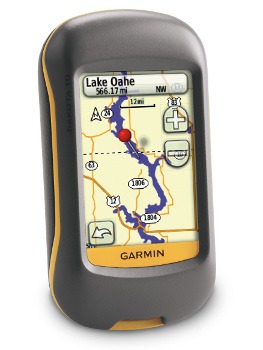 The Garmin Dakota 10
The Garmin Dakota 10 is a smaller version of Garmin’s successful Oregon models. The Dakotas appear poised to replace the eTrex series, bringing all of the Oregon’s touch screen goodness while retaining the eTrex’s small form factor, light weight and long battery life.
Both units in the two-model Dakota series sport a 2.6” screen. Neither model comes with pre-loaded topo maps, but both can accommodate the many free topo maps available for Garmin units, Garmin custom maps and the forthcoming BirdsEye imagery. EDIT: Garmin threw us a curve ball on this one. They are now saying that the Dakota 10 will not support BirdsEye imagery, due to the lack of an expansion card slot. EDIT 2: They have now made the Dakota 10 compatible with BirdsEye imagery. The Dakota 10 is the entry-level model, but is still an awesome unit, thanks to the aforementioned mapping capabilities, it’s touch screen and paperless geocaching features.
Related models
- Step up to the Dakota 20, and you’ll get a tri-axial electronic compass, barometric altimeter, wireless data transfer between units and the ability to accept a micro-SD card (the Dakota 10 is limited to 850 MB of internal memory for added maps, which is still a lot, so you may not need an expansion slot)
- To see how the Dakota 10 stands up against other Garmin models, check out my Garmin handheld GPS comparison chart
Portions of the following were taken from my hands on review of the Garmin Dakota 20.
Comparing to the Oregon series
Before we get into the details, let’s also compare the Dakota to the Oregon series. The Dakota units have (theoretically) longer battery life and weigh less (5.25 oz. vs. 6.8 oz.), while the Oregons have a larger screen (3.0”) and add 3D views, Wherigo support, a photo viewer, and NMEA / Spanner support.
The image below (Dakota, left; Oregon, right) compares how screen size affects the area you can see covered in terms of map display. 
The other difference worth mentioning is screen visibility…
Touchscreen display
While the Oregon has a brighter backlight, the Dakota is a bit more visible under daylight and outdoors conditions. All of the newer generation high-resolution GPS screens suffer a bit when it comes to visibility, but it seems like Garmin is making some progress in this arena. I do a fair bit of mountain biking, and the Dakota is the first hi-res touch screen unit I consider suitable for fixed mount, non-powered use (e.g., bike handlebars). Visibility isn’t a big deal when you carry one of these units in your hand, as you’ll intuitively tilt it for the best view without thought. Nor is it an issue when powered with a car adapter, etc. But after being disappointed with previous touch screen models, I was pleased to see how readable the Dakota’s display was on my bike’s handlebars, even when wearing tinted glasses.
|
|
Visibility was good in direct, full sunlight (there were points where it was as bright as my 60CSx in full sun). It looked great in dark shade too. The Dakota screen’s performance was weakest at points in between – light shade or indirect light.
My testing was done with the backlight on; I expect this is how most people will use it. I kept it set to time out at two minutes.
This is a bit off-topic, but it sure would be nice to have a low profile handlebar mount that would allow you to adjust the angle, in two planes, on the fly. It could certainly improve visibility.
Before leaving the subject, I’ll add that I recommend using a screen protector for handheld touchscreen GPS receivers.
Garmin Dakota 10 interface
The interface is basically the same as that of the Garmin Oregon, with a main menu of 24 items spread across four screens (see below). It’s pretty intuitive and easy to use, but it gets much better if you take the time to customize it. Here are some tips:
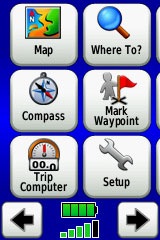 Use profiles – There is a “Change profiles” item on the main menu, and you can create a new one via Setup > Profiles. Tap the new profile to give it a name. Now start changing various preferences. Want track up when geocaching and north up when biking? No problem. The possibilities are nearly endless.
Use profiles – There is a “Change profiles” item on the main menu, and you can create a new one via Setup > Profiles. Tap the new profile to give it a name. Now start changing various preferences. Want track up when geocaching and north up when biking? No problem. The possibilities are nearly endless.- Rearrange the main menu – Set this different for each profile. I make extensive use of the Track Manager, so that gets moved to the first main menu screen for my hiking and biking profiles.
- Create sun and shade profiles – A great use of this tool is to create a sun profile (perhaps even one for each activity). Create this profile and then go to Setup > Maps > Advanced Map Setup. Set Shaded Relief to Do Not Show to enhance visibility in bright light. If you have Garmin topo maps installed, you can get rid of the green background found in park areas by going to Setup > Map > Advanced Map Setup > Zoom Levels > Land Cover and turn it off. Credit goes to GPS Fix for originating these tips.
The keypad is a little more cramped on the Dakota than the Oregon, due to the smaller screen, but I found that I quickly got used to this and it did not result in a significant increase in errors.
Shown below are the compass and trip computer screens. The data fields can, of course, be customized, as can the background color. The trip computer screen can be also switched to show fewer (but larger) fields.
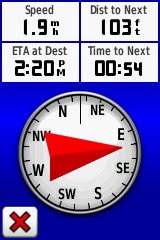
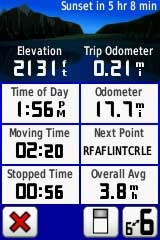
Finally, here’s a random interface tip… When you select a location on the map, a push pin appears. You can now slide the map around underneath the pin, and zoom in as needed, to fine tune the selected location.. 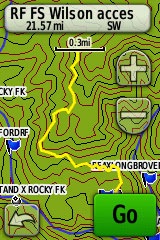
Route, Track and Waypoint management
The Dakota 10 has the same excellent route, track and waypoint management tools found on the Oregon series. These include:
- Waypoints – The ability to project a waypoint, and to reposition one at your current location.
- Tracks – You can choose to hide or show a track on the map and give it a custom color (17 colors are available). The image at the right shows the View Track preview option.
- Routes – You can view a map of the entire route, edit the route, reverse it and view an elevation plot.
Geocaching with the Dakota 10
The Dakota is set up for full paperless geocaching support, meaning you can see the description, logs, and hint, and you can log your attempt (find, DNF, etc.) for later transfer back to geocaching.com. Speaking of which, full access to these features requires a premium membership at geocaching.com. Shown below, clockwise from top left: Closest geocaches, geocache description, menu for a specific cache, and preview map.


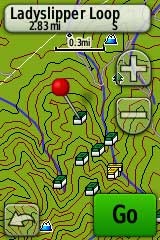
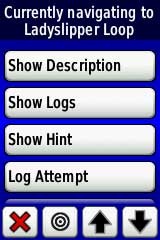
GPS receiver and battery performance
The tests below were conducted with a Dakota 20, but the 10 should give similar performance.
Battery life was tested using fully charged 2,000 mAh Eneloop NiMH rechargeable batteries. Results ranged from 16 to 16.75 hours, without backlight use, under light canopy. Interestingly enough, the longer figure was achieved using the Alkaline battery type setting. I’m not sure this is any better than my Oregon 400t, which is only rated for 16 hours vs 20 hours for the Dakota. Perhaps this will be improved in a future firmware release.
Satellite lock was achieved in 14 seconds, with testing done under no canopy.
In tests for accuracy, the Dakota performed very well. A sample comparison is shown below, matching it up against the Garmin 60CSx. Track point collection was set for five second intervals on both devices. This test took place under fairly dense canopy.
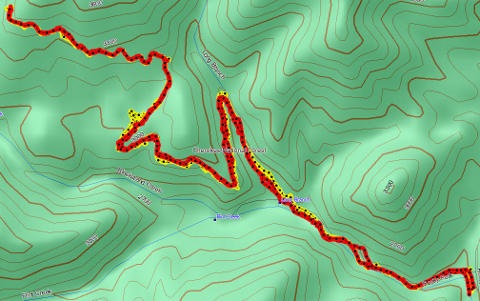 Since it’s very difficult to see the relevant details in such a small image, I’m providing links below where you can download the .gpx or .gdb (MapSource) files below. The 60CSx is in yellow and the Dakota track is red. While the Dakota went wide at one point by about 140 feet, the 60CSx exhibited much more “spidering” during stops, wandering around 240 feet at one point. Maybe my 60CSx is showing signs of age, but regardless of the comparison, I was quite impressed with the Dakota’s performance.
Since it’s very difficult to see the relevant details in such a small image, I’m providing links below where you can download the .gpx or .gdb (MapSource) files below. The 60CSx is in yellow and the Dakota track is red. While the Dakota went wide at one point by about 140 feet, the 60CSx exhibited much more “spidering” during stops, wandering around 240 feet at one point. Maybe my 60CSx is showing signs of age, but regardless of the comparison, I was quite impressed with the Dakota’s performance.
The track files are available at:
Garmin Dakota 10 pros
- Compact and light weight
- Great touch screen interface
- Slightly better sunlight visibility than Oregon series
- Ability to customize display and menus using profiles
- Excellent track management tools
- Paperless geocaching support
- Availability of free maps
- Accepts Garmin custom raster maps
- Good battery life
Garmin Dakota 10 cons
- Much poorer sunlight visibility than eTrex and GPSMAP color units
- Small screen limits map area that can be seen
Recommendation
Highly recommended. The Dakota series are the first touch screen units I’ve found suitable for fixed-mount, non-powered use (e.g., mountain bikes). It will also appeal to those looking to economize, or folks desiring a lightweight or more compact unit than the Oregon series. The Dakota is a great choice for hikers, bikers, geocachers and just about any other category of handheld users.
More Garmin Dakota 10 reviews
- Consumer-authored Garmin Dakota 10 reviews
have been posted at Amazon
- Geocacher reviews of the Dakota 10
- Appalachia & Beyond reviews the Dakota 10
I’ll be posting more hands on GPS reviews as they appear, but in the meantime, here are some…
Other Garmin Dakota 10 resources
- The Garmin Dakota 10 owners manual, in the language of your choice
- See how the Dakota 10 stands up to other units with this Garmin comparison tool or use my own Garmin handheld GPS comparison chart
- This Garmin Dakota wiki includes a message forum
- An interactive Garmin Dakota demo page
- The official Garmin Dakota 10 web page
- Garmin Dakota training videos
Compare prices on the Garmin Dakota 10 at these merchants:
- Check the current Garmin Dakota 10
price at Amazon
- get a great price on the Garmin Dakota 10 Hand-held Waterproof Hiking GPS
at Beach Camera
- Check out the deal on the Garmin Dakota 10 GPS
at REI.com, where satisfaction is guaranteed and members get 10% back on eligible purchases


Before i start my comment allow me to thank you for all the valuable info provided by you on this site. I do appreciate it very much.
In your review you mention that the Dakota 10 can project waypoints. PLEASE tell me how to do that because i need this facility when hunting Jackall.
Also, how can i get the bearing displayed in langtitude/longtitude.
Thank you so much
You’re welcome!
I’m looking at an Oregon, but it should be the same.
Go to Waypoint Manager and select a waypoint, then select Project Waypoint and enter a bearing.
Another similar function is Sight ‘N Go, available from the main menu. I’m not sure which function you need.
Also, bearings are given in degrees. Do you mean how to display coordinates in lat/long?
Thank yo very much for your answer to my question. I have found the “project waypoint” option but where can i get the bearing to enter. Must i write it down as displayed on my GPS or is there an easier option like maybe a copy and paste??
Thanka again
I’m still not sure exactly what you are trying to do. Where on the GPS would you find the bearing?
If i go out at night to hunt Jackal and hear the sound of a howling jackal at a distance i want to get the bearing(direction) of where the sound came from, plot it on my gps, project the waypoint, and move there. I hope this explaines what i am trying to do.
Maybe i must get myself a GPS with an electronic compass which i can point in the direction of the sound and get the projected waypoint. I read in the reviews that this is what the electronic compass is suppose to do. Dont know if you agree with me.
Thanks
JP, the electronic compass shouldn’t be an issue, but you will need to be walking before using the following procedure (without an electronic compass, the GPS receiver can’t tell which way you are moving until you have taken a few steps in a straight line). I would use the Sight N’ Go screen (I’m pretty sure it’s included on the Dakota). Once you start moving, choose Sight N’ Go, then point it in the direction of the howl. Press Lock Direction. Then choose Set Course, or if you want to estimate the distance, select Project Waypoint. Hope this helps.
Hi Rich
Thanks for your patience and all your help. Unfortunately the Dakota 10 dont have the Sight N Go option. That is exactly what i needed but i will try to manage without it. Thanks again
And I’m betting it doesn’t have Project Waypoint either.
Wow! This web page has been very helpful! I bought this for my boyfriend as a surprise and this site has so many resources that will help him get started! This is the first time I’ve heard of “caching” and it’s something I know he hasn’t heard about yet either and it sounds like so much fun! I can’t wait until he and I can get exploring and this site will be such a huge help!
Cool! Glad it helped. Feel free to ask if you have any questions. And be sure to check out the free topo maps at http://gpsfiledepot.com.
I’m thinking of purchasing a Dakota 10 . I have seen that there is a hike and bike bundle , also thereof a bundle available at dicks sporting goods with a topo of the US. Which would be the better choice? Would the topo version be overkill for an occasional hiker like me ? Or should I get the hike and bike version and download the free garmin topo maps ? How detailed are the downloadable maps and how do they compare to the map that comes with the topo bundle ? Thanks in advance for your answer .
Get the hike and bike version with highway maps and then download the free topos. I think the Dicks bundle has 100K scale topos, whereas the free ones are 24K — much more detailed.
I have a Dakota 10 and would like to use it when driving my car, and motorcycle, but, it doesn’t show any secondary roads. Am I missing something or is there a download that I need to do? I’m confused about it. My Garmin Nuvi250 has been a good unit for traveling.
It doesn’t come with any detailed maps. If you want the kind of functionality you get with your nuvi, you’ll need to add City Navigator maps or Garmin’s new 24K topo series, which includes City Navigator data.
If you don’t need to navigate to addresses or POIs, there are some free solutions like http://downloads.cloudmade.com/ and http://garmin.openstreetmap.nl/.
I would have thought that a $300 unit would at least have what a $100 dollar unit would have already installed. If it’s for use with bicycles, how would you find the secondary roads hat you might normally use to ride on. I understand if it’sonly for mountain bikes but, seems like Garmin just wants to make you pay for what should be there already. Maybe I can trade with somebody for an automobile use one like my older one. I had assumed the automotive mode on it would be just that.
Handheld units tend to be more expensive because they sell less of them. You can get a cheaper auto unit with highway maps pre-loaded, but it won’t be waterproof and will be more likely to break if you crash. It also won’t allow to load and navigate tracks, or use Birds Eye aerial imagery or Garmin custom maps. Most won’t allow for paperless geocaching or have a compass screen either.
I understand, my problem for me is thinking of my use and what it will cost me. This thing doesn’t have an SD card which the free sites said I needed to have to load their maps. Looks like something like $79.00 is what I saw for a maps upload to it from the Garmin site. I can buy a suitable GPS from Target or Wally world for less than that and probably be happy with it. I thought I’d be able to use this one on my motorcycle but, I can use an automobile one easily. I just assumed since there was an automobile setting on this unit and the fact it’s small and has the other features, that It would have been perfect. I’ll just advertise it locally and try to trade for one that’ll do what I’m looking for. Thanks for your help and education however.
Rich,
First off,… my face is red! I decided to so called “read the instructions”,and found that, I was given a DVD of Garmins, “City Navigator North America NT”. In following through the instructions , I found I could send the maps from it to my Dakota 10 and after sending the whole East coast states to it and rechecking what I have, I have all the city and county roads and streets all there. Now I can use the Dakota as my navigator while in a car or on my motorcycle. I should have known it was gonna be something I wasn’t doing correctly. That’s my M.O. as they say on police TV shows. I apologize for being a Stupid. And thanks for your input, it made me use my brain for something more than a hat rack.
Ah, you got a bundle that includes highway maps. Changes everything, huh?
Give a yell if you have any questions. Glad you found that. I never thought of it.
Thanks, I tried it around town driving and all is well, I’m gonna be happy with it!
Hi,
I am about to purchase some gps handheld units for my company. We primarily need them for locating long/lat. We need the readings to be in Degrees, Minutes to one hundredth of a minute. I am looking at the Dakota 10 and the GPSMAP 60 CSX. Could you advice how the long/lat are displayed and if that is a feature that can be customized.
Thanks,
Stephen
I just checked on the 60CSx and the 62s (the Dakota should be the same). Degrees, Minutes is reported to 1/1000th of a minute, for example, N 35 degrees 18.978 minutes.
You cannot customize this, but you can convert to various formats including DMS.
I purchased a used Dakota 10. and I don’t understand the format usng. None of the geocaching caches list this format in their conversion list unless I’m missing something. About 7 years ago I use to geocache but I used the etrex legend and seemed easier
heh i figured it out. just had to arrow down
Glad you got it figured out.
My Garmin eTrex allows me to check the time of day; however, I haven’t been able to find the time on my Dakota, and the owners manual is not helpful. Can you provide some guidance? Thank you.
Assuming that it’s like my Oregon, there are a number of ways to do this. One would be to press setup > map > data fields > 2. Now you will see two boxes at the top of the map screen. Tap one of them and you can choose what you want to display there. Time of Day is one of the options.
Another is to simply tap the Trip Computer button on the main menu. Tap any of the data fields and you can choose Time of Day there too.
There should be other options also, like dashboards.
Thanks Boyd. It’s always nice to get some help answering questions. I very much appreciate it.
well…for me it did not work as well…on its third outing, the screen failed.
How so? Cracked, non-responsive?
I am looking for a unit to use on my boat, would this unit work for plotting points on a lake?
Yes. Almost all handheld GPS units will allow you to create waypoints. This is a good intro to the terminology BTW…
http://gpstracklog.com/category/handheld-sport-gps/handheld-gps-101
I was wondering what would be the better unit to get the Dakota 10 or the E trex 20. I would be using it for geo caching and also hiking and hunting. I am kind of torn between the two on what to get. The both have nice features. Any suggestiond would be great. Thanks
I’ve heard quite a few complaints about busted Dakotas. Hopefully the eTrex 20 is a bit more rugged. I also like the fact that it has both GPS and GLONASS capabilities.
This was our first GPS unit. It was really great and easy to learn, the map was off a little. This was really noticeable when next to water as it would show us in water when we weren’t. I also liked the tracking feature as well. I upgraded to a smart phone map because we use it for Geocaching and a smart phone is much easier due to the satellite images (dakota doesn’t have them).
This was our first GPS unit. It was really great and easy to learn, the map was off a little. This was really noticeable when next to water as it would show us in water when we weren’t. I also liked the tracking feature as well. I upgraded to a smart phone map because we use it for Geocaching and a smart phone is much easier due to the satellite images (dakota doesn’t have them).
On my Dakota 10how do I get the coordinates displayed while I am moving?
Tap any data field and select Location.
Which would be better for me to purchase for my boyfriend. The Garmin Dakota 10 or Garmin Etrex 20? He likes to hike off the path and does some caving every once in a while. I wish I could get him the $200-$400, but it’s not possible. Any advice would be greatly appreciated!! I have no clue! Thanks:)
I would go with the eTrex 20. It’s more accurate and less fragile, although it does lack the touchscreen. Whatever you get, if he’s never used a GPS before, have him check this out, especially the handheld GPS 101 section: http://gpstracklog.com/handheld-gps-faqs
Ok Thank you! I have been searching for months and every time I am set on the etrex I will see something else. Would you still recommend the Etrex 20 over the Garmin Foretrex 401? He has used a handheld GPS before. He had one a few years back and it broke during a move. Thanks again!
I would definitely recommend the eTrex 20 over the Foretrex.